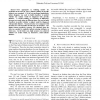Free Online Productivity Tools
i2Speak
i2Symbol
i2OCR
iTex2Img
iWeb2Print
iWeb2Shot
i2Type
iPdf2Split
iPdf2Merge
i2Bopomofo
i2Arabic
i2Style
i2Image
i2PDF
iLatex2Rtf
Sci2ools
IJCNN
2006
IEEE
2006
IEEE
Predicting Juvenile Diabetes from Clinical Test Results
—Two approaches to building models for prediction of the onset of Type 1 diabetes mellitus in juvenile subjects were examined. A set of tests performed immediately before diagnosis was used to build classifiers to predict whether the subject would be diagnosed with juvenile diabetes. A second training set consisting of differences between test results taken at different times was used to build classifiers to predict whether a subject would be diagnosed with juvenile diabetes. Neural networks were compared with decision trees and ensembles of both types of classifiers. The highest known predictive accuracy was obtained when the data was encoded to explicitly indicate missing attributes in both cases. In the latter case, high accuracy was achieved without test results which, by themselves, could indicate diabetes.
| Added | 11 Jun 2010 |
| Updated | 11 Jun 2010 |
| Type | Conference |
| Year | 2006 |
| Where | IJCNN |
| Authors | Shibendra S. Pobi, Lawrence O. Hall |
Comments (0)

